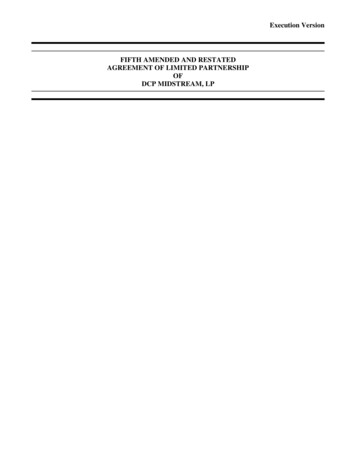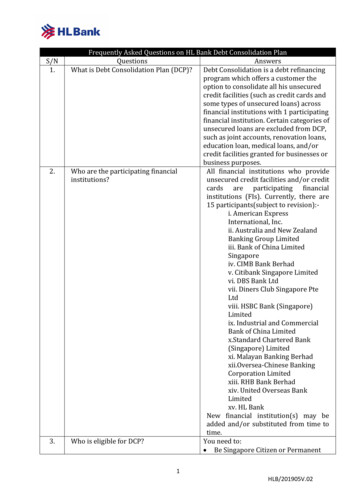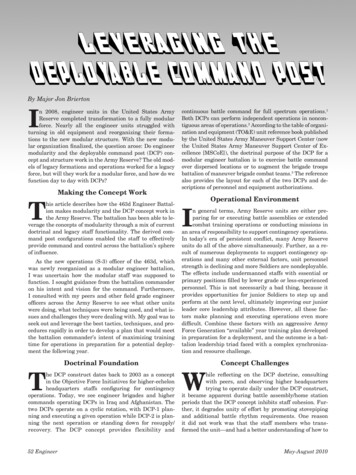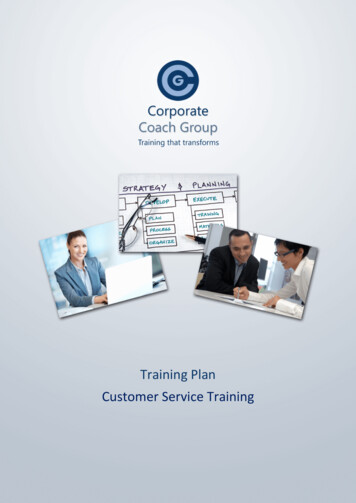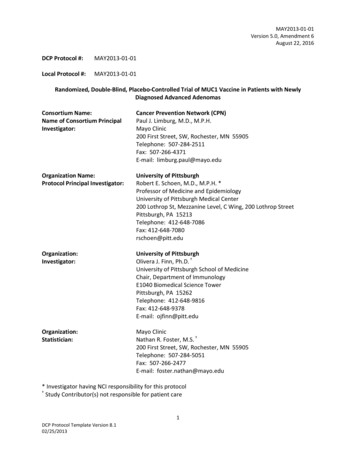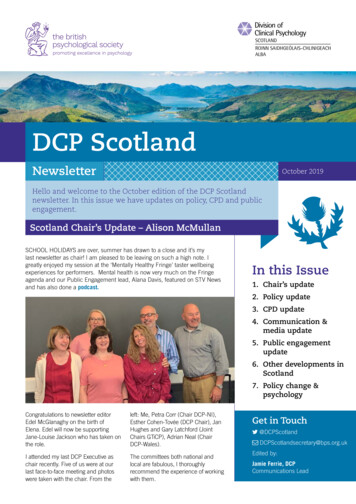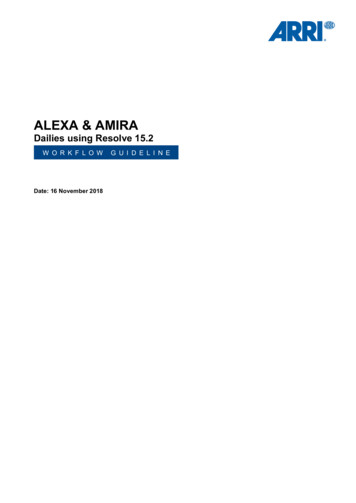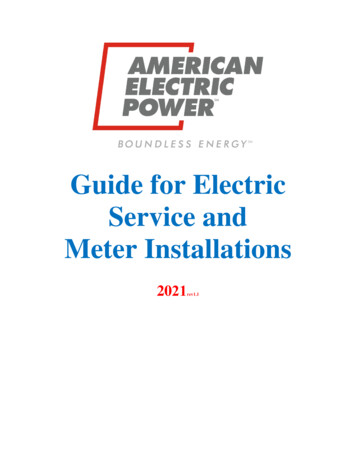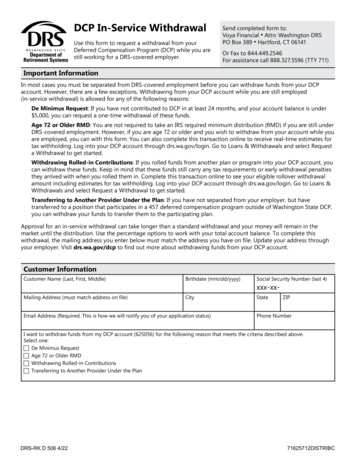
Transcription
Clear FormDCP In-Service WithdrawalUse this form to request a withdrawal from yourDeferred Compensation Program (DCP) while you arestill working for a DRS-covered employer.Send completed form to:Voya Financial ꔷ Attn: Washington DRSPO Box 389 ꔷ Hartford, CT 06141Or Fax to 844.449.2546For assistance call 888.327.5596 (TTY 711)Important InformationIn most cases you must be separated from DRS-covered employment before you can withdraw funds from your DCPaccount. However, there are a few exceptions. Withdrawing from your DCP account while you are still employed(in-service withdrawal) is allowed for any of the following reasons:De Minimus Request: If you have not contributed to DCP in at least 24 months, and your account balance is under 5,000, you can request a one-time withdrawal of these funds.Age 72 or Older RMD: You are not required to take an IRS required minimum distribution (RMD) if you are still underDRS-covered employment. However, if you are age 72 or older and you wish to withdraw from your account while youare employed, you can with this form. You can also complete this transaction online to receive real-time estimates fortax withholding. Log into your DCP account through drs.wa.gov/login. Go to Loans & Withdrawals and select Requesta Withdrawal to get started.Withdrawing Rolled-in Contributions: If you rolled funds from another plan or program into your DCP account, youcan withdraw these funds. Keep in mind that these funds still carry any tax requirements or early withdrawal penaltiesthey arrived with when you rolled them in. Complete this transaction online to see your eligible rollover withdrawalamount including estimates for tax withholding. Log into your DCP account through drs.wa.gov/login. Go to Loans &Withdrawals and select Request a Withdrawal to get started.Transferring to Another Provider Under the Plan: If you have not separated from your employer, but havetransferred to a position that participates in a 457 deferred compensation program outside of Washington State DCP,you can withdraw your funds to transfer them to the participating plan.Approval for an in-service withdrawal can take longer than a standard withdrawal and your money will remain in themarket until the distribution. Use the percentage options to work with your total account balance. To complete thiswithdrawal, the mailing address you enter below must match the address you have on file. Update your address throughyour employer. Visit drs.wa.gov/dcp to find out more about withdrawing funds from your DCP account.Customer InformationCustomer Name (Last, First, Middle)Birthdate (mm/dd/yyyy)Social Security Number (last 4)Mailing Address (must match address on file)CityStateEmail Address (Required. This is how we will notify you of your application status)xxx-xx-ZIPPhone NumberI want to withdraw funds from my DCP account (625056) for the following reason that meets the criteria described above.Select one:c De Minimus Requestc Age 72 or Older RMDc Withdrawing Rolled-in Contributionsc Transferring to Another Provider Under the PlanDRS-RK D 506 4/2271625712DISTRIBC
Withdrawal Type (select all that apply)Any partial withdrawal will be distributed evenly (pro-rata) from your current investments.c Lump Sum or Partial PaymentAmount or%A lump sum is a full (100% of your balance) or partial (less than 100% of your balance) payment paid to you.c RolloverAmount or%A rollover allows your DCP funds to be “rolled over” into another qualifying plan, such as an IRA or a 401(k). If you select thisoption, also complete the Rollover Agreement section. Rollovers are not available for De Minimus Request withdrawals.c Transfer under retirement providerAmount or%This is a one-time transfer to another 457 retirement program under your DRS-covered employer (attach letter of acceptance).Rollover Agreement (complete if you selected the rollover withdrawal type)The rollover check will be mailed to your home address on file so you can submit it to your rollover source. To updateyour address, contact your employer.Check Made Payable To (Rollover Institution Trustee Name)Account TypeAccount Numberc Eligible Employer Plan (403(b), 401(a)/(k), Governmental 457(b)c 403(a) Annuity c Individual Retirement Account c Individual Retirement Account AnnuityWithdrawal Delivery Preferencec First Class Mail(no additional charge)Estimated delivery time:Up to 5 days.c Expedited Deliveryc Direct DepositA 50 additional charge will betaken from your account.(no additional charge)Estimated delivery time: 2-3business days.Authorization for Direct Deposit (complete if you chose this delivery preference)Due to federal restrictions, we cannot transfer funds electronically if the funds will be immediately credited to anaccount outside the United States.By completing this section, you authorize that: The DRS record keeper will transfer the full amount of your withdrawal,after required IRS withholding, to the designated financial institution for deposit. Additionally, you authorize thedesignated financial institution to refund the record keeper any payments made in error.Financial Institution NameAccount Typec CheckingRouting Number (bottom left number on checks)How to find your routing and account numbersOn your checks, the routing number is on the bottomleft. The next numbers are your account. Optional: Youcan also attach a voided check with your application.If you don’t have checks, contact your financialinstitution and ask for the numbers.DRS-RK D 506 Page 2 of 3c SavingsAccount Number (after the routing number on checks) Pay toRouting NumberAccount Number71625712DISTRIBC
Tax Withholdingc I have read and agree to the “402(f) Notice of Special Tax Rules on Distributions” included with this form.We will withhold and submit taxes as required by the IRS, but you are responsible for any federal income taxes youmight need to pay on this withdrawal. See the Notice of Special Tax rules for details.Your withdrawal will be taxed as followsRollover This transaction is not taxed. Skip this section.Lump sum or partial withdrawals These are taxed at a federal withholding rate of 20%. You also have the option toincrease your withholding above 20% in the optional additional withholding section below.Installment payments less than 10 years These are taxed at a federal withholding rate of 20%. You also have theoption to increase your withholding above 20% in the optional additional withholding section below.Installment payments over 10 or more years Your withdrawal will default to the federal withholding rate of marriedwith three exemptions unless you complete the additional withholding information below. You also have the option ofselecting no withholding below to submit your own taxes.State Income Tax withholding If it is required for your state, income tax will be withheld regardless of any withholdingelection you make below. State income tax does not apply to Washington State residents.Optional Additional Withholding: Withhold income tax based on my withdrawal type, marital status and allowances.For more information about number of allowances, see IRS form W-4P.Status: c Marriedc Singlec Married but withhold at Single RateNumber of AllowancesTo have more tax withheld from each payment, enter any additional withholding here.Additional Federal Tax Withholding Additional State Tax Withholding c Optional No Withholding: (Can ONLY be applied for DCP installment payments of 10 years or more.) Don’twithhold federal income tax from my withdrawal. This option does not relieve me of any tax liability. Selection of thisbox for any other withdrawal type is invalid and will not change your withholding requirements.Signature RequiredBy signing this application, I affirm that I have carefully read (or in the case of disability, I have had read to me) andunderstand the application for this withdrawal request. All information is complete and true, represents my choices, andno material fact has been concealed or omitted. I understand that unless a statutory exception exists, my designations,options and alternatives are permanent after my application has been processed.Waiver of 30 Day Notice Period: The IRS requires that customers be given 30 days to review options for withdrawal. Mysignature here indicates I have reviewed my options and waive this 30 day hold.SignatureDateForm Submission (use one of the following options to submit this form)FaxVoya FinancialAttn: Washington State DRS844-449-2546MailVoya FinancialAttn: Washington State DRSPO Box 389Hartford, CT 06141Overnight DeliveryVoya FinancialAttn: Washington State DRSOne Orange WayWindsor, CT 06095-4774Your Social Security or Tax ID number is needed so the DRS record keeper can report to the IRS any funds paid to you.We will not disclose your information unless required to do so by law. See IRC sections 6041(a) and 6109.DRS-RK D 506 Page 3 of 371625712DISTRIBC
IRS 402(f) Notice of Special Tax Rules on DistributionsFor Payments Not From aDesignated Roth AccountYOUR ROLLOVER OPTIONSYou are receiving this notice because all or a portion of a payment you are receiving from thePlan is eligible to be rolled over to an IRA or an employer plan. This notice is intended to helpyou decide whether to do such a rollover.This notice describes the rollover rules that apply to payments from the Plan that are not from adesignated Roth account (a type of account in some employer plans that is subject to special taxrules). If you also receive a payment from a designated Roth account in the Plan, you will beprovided a different notice for that payment, and the Plan administrator or the payor will tell youthe amount that is being paid from each account.Rules that apply to most payments from a plan are described in the “General Information AboutRollovers” section. Special rules that only apply in certain circumstances are described in the“Special Rules and Options” section.GENERAL INFORMATION ABOUT ROLLOVERSHow can a rollover affect my taxes?You will be taxed on a payment from the Plan if you do not roll it over. If you are under age 59½and do not do a rollover, you will also have to pay a 10% additional income tax on earlydistributions (generally, distributions made before age 59½), unless an exception applies.However, if you do a rollover, you will not have to pay tax until you receive payments later andthe 10% additional income tax will not apply if those payments are made after you are age 59½(or if an exception to the 10% additional income tax applies).What types of retirement accounts and plans may accept my rollover?You may roll over the payment to either an IRA (an individual retirement account or individualretirement annuity) or an employer plan (a tax-qualified plan, section 403(b) plan, orgovernmental section 457(b) plan) that will accept the rollover. The rules of the IRA or employerplan that holds the rollover will determine your investment options, fees, and rights to paymentfrom the IRA or employer plan (for example, IRAs are not subject to spousal consent rules, andIRAs may not provide loans). Further, the amount rolled over will become subject to the tax rulesthat apply to the IRA or employer plan.How do I do a rollover?There are two ways to do a rollover. You can do either a direct rollover or a 60-day rollover.If you do a direct rollover, the Plan will make the payment directly to your IRA or an employerplan. You should contact the IRA sponsor or the administrator of the employer plan forinformation on how to do a direct rollover.If you do not do a direct rollover, you may still do a rollover by making a deposit into an IRA oreligible employer plan that will accept it. Generally, you will have 60 days after you receive thepayment to make the deposit. If you do not do a direct rollover, the Plan is required to withhold20% of the payment for federal income taxes (up to the amount of cash and property receivedother than employer stock). This means that, in order to roll over the entire payment in a 60-dayrollover, you must use other funds to make up for the 20% withheld. If you do not roll over theentire amount of the payment, the portion not rolled over will be taxed and will be subject to the10% additional income tax on early distributions if you are under age 59½ (unless an exceptionapplies).08/06/2020171STNCFNR
How much may I roll over?If you wish to do a rollover, you may roll over all or part of the amount eligible for rollover. Anypayment from the Plan is eligible for rollover, except: Certain payments spread over a period of at least 10 years or over your life or lifeexpectancy (or the joint lives or joint life expectancies of you and your beneficiary);Required minimum distributions after age 70½ (if you were born before July 1, 1949),after age 72 (if you were born after June 30, 1949), or after death;Hardship distributions;Payments of employee stock ownership plan (ESOP) dividends;Corrective distributions of contributions that exceed tax law limitations;Loans treated as deemed distributions (for example, loans in default due to missedpayments before your employment ends);Cost of life insurance paid by the Plan;Payments of certain automatic enrollment contributions that you request to withdrawwithin 90 days of your first contribution;Amounts treated as distributed because of a prohibited allocation of S corporation stockunder an ESOP (also, there generally will be adverse tax consequences if you roll over adistribution of S corporation stock to an IRA); andDistributions of certain premiums for health and accident insurance.The Plan administrator or the payor can tell you what portion of a payment is eligible forrollover.If I don’t do a rollover, will I have to pay the 10% additional income tax on earlydistributions?If you are under age 59½, you will have to pay the 10% additional income tax on earlydistributions for any payment from the Plan (including amounts withheld for income tax) that youdo not roll over, unless one of the exceptions listed below applies. This tax applies to the part ofthe distribution that you must include in income and is in addition to the regular income tax onthe payment not rolled over.The 10% additional income tax does not apply to the following payments from the Plan: Payments made after you separate from service if you will be at least age 55 in the yearof the separation;Payments that start after you separate from service if paid at least annually in equalor close to equal amounts over your life or life expectancy (or the joint lives or jointlife expectancies of you and your beneficiary);Payments from a governmental plan made after you separate from service if you are aqualified public safety employee and you will be at least age 50 in the year of theseparation;Payments made due to disability;Payments after your death;Payments of ESOP dividends;Corrective distributions of contributions that exceed tax law limitations;Cost of life insurance paid by the Plan;Payments made directly to the government to satisfy a federal tax levy;Payments made under a qualified domestic relations order (QDRO);Payments of up to 5,000 made to you from a defined contribution plan if the paymentis a qualified birth or adoption distribution;08/06/2020271STNCFNR
Payments up to the amount of your deductible medical expenses (without regard towhether you itemize deductions for the taxable year);Certain payments made while you are on active duty if you were a member of a reservecomponent called to duty after September 11, 2001 for more than 179 days;Payments of certain automatic enrollment contributions that you request to withdrawwithin 90 days of your first contribution;Payments excepted from the additional income tax by federal legislation relating tocertain emergencies and disasters; andPhased retirement payments made to federal employees.If I do a rollover to an IRA, will the 10% additional income tax apply to early distributionsfrom the IRA?If you receive a payment from an IRA when you are under age 59½, you will have to pay the10% additional income tax on early distributions on the part of the distribution that you mustinclude in income, unless an exception applies. In general, the exceptions to the 10% additionalincome tax for early distributions from an IRA are the same as the exceptions listed above forearly distributions from a plan. However, there are a few differences for payments from an IRA,including: The exception for payments made after you separate from service if you will be at leastage 55 in the year of the separation (or age 50 for qualified public safety employees)does not apply;The exception for qualified domestic relations orders (QDROs) does not apply (althougha special rule applies under which, as part of a divorce or separation agreement, a taxfree transfer may be made directly to an IRA of a spouse or former spouse); andThe exception for payments made at least annually in equal or close to equal amountsover a specified period applies without regard to whether you have had a separationfrom service.Additional exceptions apply for payments from an IRA, including: Payments for qualified higher education expenses;Payments up to 10,000 used in a qualified first-time home purchase; andPayments for health insurance premiums after you have received unemploymentcompensation for 12 consecutive weeks (or would have been eligible to receiveunemployment compensation but for self-employed status).Will I owe State income taxes?This notice does not address any State or local income tax rules (including withholdingrules).SPECIAL RULES AND OPTIONSIf your payment includes after-tax contributionsAfter-tax contributions included in a payment are not taxed. If you receive a partial payment ofyour total benefit, an allocable portion of your after-tax contributions is included in the payment,so you cannot take a payment of only after-tax contributions. However, if you have pre-1987after-tax contributions maintained in a separate account, a special rule may apply to determinewhether the after-tax contributions are included in the payment. In addition, special rules applywhen you do a rollover, as described below.You may roll over to an IRA a payment that includes after-tax contributions through either adirect rollover or a 60-day rollover. You must keep track of the aggregate amount of the after-tax08/06/2020371STNCFNR
contributions in all of your IRAs (in order to determine your taxable income for later paymentsfrom the IRAs). If you do a direct rollover of only a portion of the amount paid from the Plan andat the same time the rest is paid to you, the portion rolled over consists first of the amount thatwould be taxable if not rolled over. For example, assume you are receiving a distribution of 12,000, of which 2,000 is after-tax contributions. In this case, if you directly roll over 10,000to an IRA that is not a Roth IRA, no amount is taxable because the 2,000 amount not rolledover is treated as being after-tax contributions. If you do a direct rollover of the entire amountpaid from the Plan to two or more destinations at the same time, you can choose whichdestination receives the after-tax contributions.Similarly, if you do a 60-day rollover to an IRA of only a portion of a payment made to you, theportion rolled over consists first of the amount that would be taxable if not rolled over. Forexample, assume you are receiving a distribution of 12,000, of which 2,000 is after-taxcontributions, and no part of the distribution is directly rolled over. In this case, if you roll over 10,000 to an IRA that is not a Roth IRA in a 60-day rollover, no amount is taxable because the 2,000 amount not rolled over is treated as being after-tax contributions.You may roll over to an employer plan all of a payment that includes after-tax contributions,but only through a direct rollover (and only if the receiving plan separately accounts for aftertax contributions and is not a governmental section 457(b) plan). You can do a 60-day rolloverto an employer plan of part of a payment that includes after-tax contributions, but only up tothe amount of the payment that would be taxable if not rolled over.If you miss the 60-day rollover deadlineGenerally, the 60-day rollover deadline cannot be extended. However, the IRS has the limitedauthority to waive the deadline under certain extraordinary circumstances, such as when externalevents prevented you from completing the rollover by the 60-day rollover deadline. Under certaincircumstances, you may claim eligibility for a waiver of the 60-day rollover deadline by making awritten self-certification. Otherwise, to apply for a waiver from the IRS, you must file a privateletter ruling request with the IRS. Private letter ruling requests require the payment of anonrefundable user fee. For more information, see IRS Publication 590-A, Contributions toIndividual Retirement Arrangements (IRAs).If your payment includes employer stock that you do not roll overIf you do not do a rollover, you can apply a special rule to payments of employer stock (or otheremployer securities) that are either attributable to after-tax contributions or paid in a lump sumafter separation from service (or after age 59½, disability, or the participant’s death). Under thespecial rule, the net unrealized appreciation on the stock will not be taxed when distributed fromthe Plan and will be taxed at capital gain rates when you sell the stock. Net unrealizedappreciation is generally the increase in the value of employer stock after it was acquired by thePlan. If you do a rollover for a payment that includes employer stock (for example, by selling thestock and rolling over the proceeds within 60 days of the payment), the special rule relating tothe distributed employer stock will not apply to any subsequent payments from the IRA or,generally, the Plan. The Plan administrator can tell you the amount of any net unrealizedappreciation.If you have an outstanding loan that is being offsetIf you have an outstanding loan from the Plan, your Plan benefit may be offset by the outstandingamount of the loan, typically when your employment ends. The offset amount is treated as adistribution to you at the time of the offset. Generally, you may roll over all or any portion of theoffset amount. Any offset amount that is not rolled over will be taxed (including the 10%additional income tax on early distributions, unless an exception applies). You may roll overoffset amounts to an IRA or an employer plan (if the terms of the employer plan permit the plan toreceive plan loan offset rollovers).08/06/2020471STNCFNR
How long you have to complete the rollover depends on what kind of plan loan offset you have.If you have a qualified plan loan offset, you will have until your tax return due date (includingextensions) for the tax year during which the offset occurs to complete your rollover. A qualifiedplan loan offset occurs when a plan loan in good standing is offset because your employer planterminates, or because you sever from employment. If your plan loan offset occurs for any otherreason (such as a failure to make level loan repayments that results in a deemed distribution),then you have 60 days from the date the offset occurs to complete your rollover.If you were born on or before January 1, 1936If you were born on or before January 1, 1936 and receive a lump sum distribution that you donot roll over, special rules for calculating the amount of the tax on the payment might apply toyou. For more information, see IRS Publication 575, Pension and Annuity Income.If your payment is from a governmental section 457(b) planIf the Plan is a governmental section 457(b) plan, the same rules described elsewhere in thisnotice generally apply, allowing you to roll over the payment to an IRA or an employer plan thataccepts rollovers. One difference is that, if you do not do a rollover, you will not have to pay the10% additional income tax on early distributions from the Plan even if you are under age 59½(unless the payment is from a separate account holding rollover contributions that were made tothe Plan from a tax-qualified plan, a section 403(b) plan, or an IRA). However, if you do arollover to an IRA or to an employer plan that is not a governmental section 457(b) plan, a laterdistribution made before age 59½ will be subject to the 10% additional income tax on earlydistributions (unless an exception applies). Other differences include that you cannot do arollover if the payment is due to an “unforeseeable emergency” and the special rules under “Ifyour payment includes employer stock that you do not roll over” and “If you were born on orbefore January 1, 1936” do not apply.If you are an eligible retired public safety officer and your payment is used to pay forhealth coverage or qualified long-term care insuranceIf the Plan is a governmental plan, you retired as a public safety officer, and your retirement wasby reason of disability or was after normal retirement age, you can exclude from your taxableincome Plan payments paid directly as premiums to an accident or health plan (or a qualifiedlong-term care insurance contract) that your employer maintains for you, your spouse, or yourdependents, up to a maximum of 3,000 annually. For this purpose, a public safety officer is alaw enforcement officer, firefighter, chaplain, or member of a rescue squad or ambulance crew.If you roll over your payment to a Roth IRAIf you roll over a payment from the Plan to a Roth IRA, a special rule applies under which theamount of the payment rolled over (reduced by any after-tax amounts) will be taxed. In general,the 10% additional income tax on early distributions will not apply. However, if you take theamount rolled over out of the Roth IRA within the 5-year period that begins on January 1 of theyear of the rollover, the 10% additional income tax will apply (unless an exception applies).If you roll over the payment to a Roth IRA, later payments from the Roth IRA that are qualifieddistributions will not be taxed (including earnings after the rollover). A qualified distribution from aRoth IRA is a payment made after you are age 59½ (or after your death or disability, or as aqualified first-time homebuyer distribution of up to 10,000) and after you have had a Roth IRAfor at least 5 years. In applying this 5-year rule, you count from January 1 of the year for whichyour first contribution was made to a Roth IRA. Payments from the Roth IRA that are notqualified distributions will be taxed to the extent of earnings after the rollover, including the 10%additional income tax on early distributions (unless an exception applies). You do not have totake required minimum distributions from a Roth IRA during your lifetime. For more information,see IRS Publication 590-A, Contributions to Individual Retirement Arrangements (IRAs), and IRSPublication 590-B, Distributions from Individual Retirement Arrangements (IRAs).08/06/2020571STNCFNR
If you do a rollover to a designated Roth account in the PlanYou cannot roll over a distribution to a designated Roth account in another employer’s plan.However, you can roll the distribution over into a designated Roth account in the distributing Plan.If you roll over a payment from the Plan to a designated Roth account in the Plan, the amount ofthe payment rolled over (reduced by any after-tax amounts directly rolled over) will be taxed. Ingeneral, the 10% additional income tax on early distributions will not apply. However, if you takethe amount rolled over out of the Roth IRA within the 5-year period that begins on January 1 ofthe year of the rollover, the 10% additional income tax will apply (unless an exception applies).If you roll over the payment to a designated Roth account in the Plan, later payments from thedesignated Roth account that are qualified distributions will not be taxed (including earnings afterthe rollover). A qualified distribution from a designated Roth account is a payment made bothafter you are age 59½ (or after your death or disability) and after you have had a designatedRoth account in the Plan for at least 5 years. In applying this 5-year rule, you count from January1 of the year your first contribution was made to the designated Roth account. However, if youmade a direct rollover to a designated Roth account in the Plan from a designated Roth accountin a plan of another employer, the 5-year period begins on January 1 of the year you made thefirst contribution to the designated Roth account in the Plan or, if earlier, to the designated Rothaccount in the plan of the other employer. Payments from the designated Roth account that arenot qualified distributions will be taxed to the extent of earnings after the rollover, including the10% additional income tax on early distributions (unless an exception applies).If you are not a Plan participantPayments after death of the participant. If you receive a distribution after the participant’s deaththat you do not roll over, the distribution generally will be taxed in the same manner describedelsewhere in this notice. However, the 10% additional income tax on early distributions and thespecial rules for public safety officers do not apply, and the special rule described under thesection “If you were born on or before January 1, 1936” applies only if the deceased participantwas born on or before January 1, 1936.If you are a surviving spouse. If you receive a payment from the Plan as the survivingspouse of a deceased participant, you have the same rollover options that theparticipant would have had, as described elsewhere in this notice. In addition, if youchoose to do a rollover to an IRA, you may treat the IRA as your own or as an inheritedIRA.An IRA you treat as your own is treated like any other IRA of yours, so that paymentsmade to you before you are age 59½ will be subject to the 10% ad
DCP In-Service Withdrawal Use this form to request a withdrawal from your Deferred Compensation Program (DCP) while you are still working for a DRS-covered employer. Send completed form to: Voya Financial ꔷ Attn: Washington DRS PO Box 389 ꔷ Hartford, CT 06141 Or Fax to 844.449.2546 For assistance call 888.327.5596 (TTY 711)

